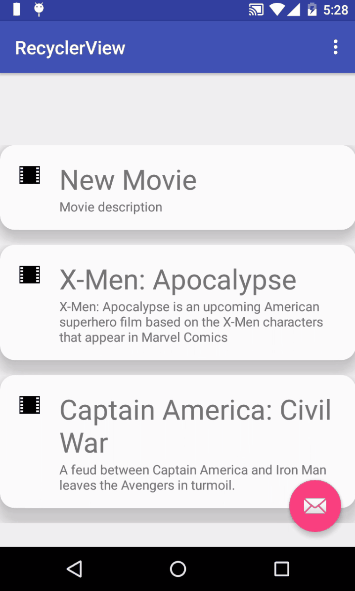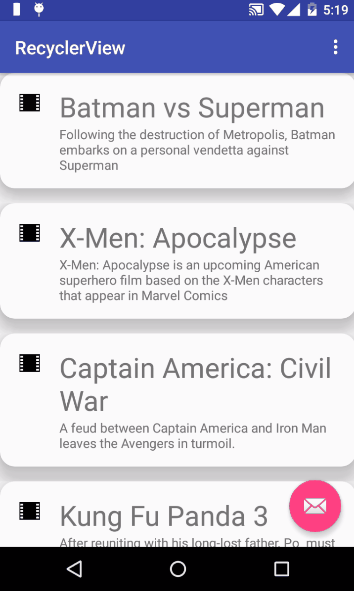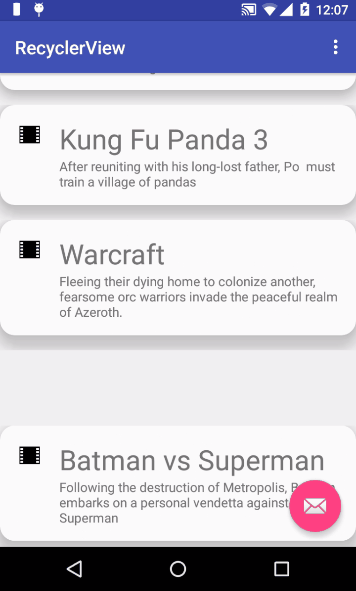- Add dependencies
- Add the RecyclerView to the layout file
- Create a custom row Layout
- The RecyclerView Adapter
- Creating the ViewHolder
- The LayoutManager
- Animating recycles with ItemAnimator
- Having trouble setting onItemClickListener to RecyclerView items?
- Conclusion
- Frequently Asked Questions (FAQs) about Mastering Complex Lists with the Android RecyclerView
For more on Android, watch our tutorial Outputting Data to Your Android App’s User Interface.
The RecyclerView was introduced with Google’s material design in Android 5.0 Lollipop.
If you are getting started with Android development or are already an experienced developer the RecyclerView is something worth investigating.
The idea of view recycling has been in Android since version 1 in the form of the ListView. The idea is simple: to present a large collection of data using a small collection of views, by recycling and rebinding these views.
The RecyclerView is a more flexible pattern of view recycling than ListViews and GridViews. What differentiates the RecyclerView from its predecessors is that it focuses only on recycling views. All the other actions needed to create a view, like how to present data set or inflate the views are delegated to the pluggable classes and that is what makes it so flexible. The hard part is setting up these classes to make a fully functional RecyclerView and that is what I will cover in this article.
To use the RecyclerView you need to follow the following steps:
- Add the support library
- Add the
RecyclerViewin the layout XML file - Create a custom row Layout
- Create the
RecyclerView.Adapterto populate data into theRecyclerView - Create the
ViewHolderto provide a reference to the views for each data item - Bind the
Adapterto theRecyclerViewin theActivity
Let’s get started with RecyclerView, you can find the code for the final project on GitHub.
Add dependencies
Open build.gradle (app) and add the dependencies needed.
dependencies {
...
compile 'com.android.support:cardview-v7:25.1.0'
compile 'com.android.support:recyclerview-v7:25.1.0'
}Sync Gradle and you are all set.
Add the RecyclerView to the layout file
<RelativeLayout
...
<android.support.v7.widget.RecyclerView
xmlns:android="http://schemas.android.com/apk/res/android"
android:id="@+id/recyclerview"
android:layout_width="match_parent"
android:layout_height="match_parent"/>
</RelativeLayout>Create a custom row Layout
The row Layout represents the Layout of each single element displayed in the RecyclerView.
Create a file named row_layout.xml and add the following to it:
<android.support.v7.widget.CardView xmlns:android="http://schemas.android.com/apk/res/android"
xmlns:app="http://schemas.android.com/apk/res-auto"
android:id="@+id/cardView"
android:layout_width="match_parent"
android:layout_height="wrap_content"
android:layout_marginBottom="@dimen/activity_vertical_margin"
android:clickable="true"
android:focusable="true"
android:foreground="?android:attr/selectableItemBackground"
app:cardCornerRadius="@dimen/activity_vertical_margin"
app:cardElevation="@dimen/activity_vertical_margin">
<RelativeLayout
android:layout_width="match_parent"
android:layout_height="wrap_content"
android:padding="16dp">
<ImageView
android:id="@+id/imageView"
android:layout_width="wrap_content"
android:layout_height="wrap_content"
android:layout_alignParentLeft="true"
android:layout_alignParentTop="true"
android:layout_marginRight="16dp" />
<TextView
android:id="@+id/title"
android:layout_width="wrap_content"
android:layout_height="wrap_content"
android:layout_alignParentTop="true"
android:layout_toRightOf="@+id/imageView"
android:text="Title"
android:textSize="30sp" />
<TextView
android:id="@+id/description"
android:layout_width="wrap_content"
android:layout_height="wrap_content"
android:layout_below="@+id/title"
android:layout_toRightOf="@+id/imageView"
android:text="Description" />
</RelativeLayout>
</android.support.v7.widget.CardView>Just a note here: when you create the item layout of the RecyclerView don’t forget to add the following lines in the ViewGroup container of the layout. This lines of code will add the ripple effect to the RecyclerView elements.
android:clickable="true"
android:focusable="true"
android:foreground="?android:attr/selectableItemBackground"The RecyclerView will be a list of randomly chosen movies and a description. We need a class that represents a single RecyclerView item data, create a file named Data.java and add the following:
public class Data {
public String title;
public String description;
public int imageId;
Data(String title, String description, int imageId) {
this.title = title;
this.description = description;
this.imageId = imageId;
}
}The RecyclerView Adapter
The RecyclerView.Adapter is similar to the Adapters used on a ListView but with a ViewHolder required to improve performance. A ListView has adapters for different sources such as the ArrayAdapter for arrays and CursorAdapter for database results. The RecyclerView.Adapter requires a custom implementation to supply data to the adapter.
The adapter has three methods.
onCreateViewHolder()inflates the row layout is and initializes the View Holder. Once the View Holder is initialized it manages thefindViewById()methods, finding the views once and recycling them to avoid repeated calls.onBindViewHolder()uses the View Holder constructed in theonCreateViewHolder()method to populate the current row of theRecyclerViewwith data.
Create a new file named Recycler_View_Adapter.java with the following class:
public class Recycler_View_Adapter extends RecyclerView.Adapter<View_Holder> {
List<Data> list = Collections.emptyList();
Context context;
public Recycler_View_Adapter(List<Data> list, Context context) {
this.list = list;
this.context = context;
}
@Override
public View_Holder onCreateViewHolder(ViewGroup parent, int viewType) {
//Inflate the layout, initialize the View Holder
View v = LayoutInflater.from(parent.getContext()).inflate(R.layout.row_layout, parent, false);
View_Holder holder = new View_Holder(v);
return holder;
}
@Override
public void onBindViewHolder(View_Holder holder, int position) {
//Use the provided View Holder on the onCreateViewHolder method to populate the current row on the RecyclerView
holder.title.setText(list.get(position).title);
holder.description.setText(list.get(position).description);
holder.imageView.setImageResource(list.get(position).imageId);
//animate(holder);
}
@Override
public int getItemCount() {
//returns the number of elements the RecyclerView will display
return list.size();
}
@Override
public void onAttachedToRecyclerView(RecyclerView recyclerView) {
super.onAttachedToRecyclerView(recyclerView);
}
// Insert a new item to the RecyclerView on a predefined position
public void insert(int position, Data data) {
list.add(position, data);
notifyItemInserted(position);
}
// Remove a RecyclerView item containing a specified Data object
public void remove(Data data) {
int position = list.indexOf(data);
list.remove(position);
notifyItemRemoved(position);
}
}Creating the ViewHolder
The RecyclerView uses a ViewHolder to store the references to the relevant views for one entry in the RecyclerView. This solution avoids all the findViewById() method calls in the adapter to find the views to be filled with data.
Create a file named View_Holder.java with the following class:
public class View_Holder extends RecyclerView.ViewHolder {
CardView cv;
TextView title;
TextView description;
ImageView imageView;
View_Holder(View itemView) {
super(itemView);
cv = (CardView) itemView.findViewById(R.id.cardView);
title = (TextView) itemView.findViewById(R.id.title);
description = (TextView) itemView.findViewById(R.id.description);
imageView = (ImageView) itemView.findViewById(R.id.imageView);
}
}The LayoutManager
The Layout Manager attaches, measures, and lays out all the child views of the RecyclerView in real-time. As the user scrolls the view, the Layout Manager determines when new child views will be added and when the old child views will be detached and deleted.
These default implementations are available:
LinearLayoutManager– Displays items in a vertical or horizontal scrolling list.GridLayoutManager– Displays items in a grid.StaggeredGridLayoutManager– Displays items in a staggered grid.
You can create a custom LayoutManager by extending RecyclerView.LayoutManager or one of the implementations above and overriding the methods required.
Now that the RecyclerView is finished the next step is to fill it with some data. In the onCreate() method of the MainActivity class create an instance of the Recycler_View_Adapter and give this adapter the list of data and the context. The getApplication() method will provide the application context.
List<Data> data = fill_with_data();
RecyclerView recyclerView = (RecyclerView) findViewById(R.id.recyclerview);
Recycler_View_Adapter adapter = new Recycler_View_Adapter(data, getApplication());
recyclerView.setAdapter(adapter);
recyclerView.setLayoutManager(new LinearLayoutManager(this));We will also need sample data, for this example I have created a default function, in a real app, this may come from a data source.
public List<Data> fill_with_data() {
List<Data> data = new ArrayList<>();
data.add(new Data("Batman vs Superman", "Following the destruction of Metropolis, Batman embarks on a personal vendetta against Superman ", R.drawable.ic_action_movie));
data.add(new Data("X-Men: Apocalypse", "X-Men: Apocalypse is an upcoming American superhero film based on the X-Men characters that appear in Marvel Comics ", R.drawable.ic_action_movie));
data.add(new Data("Captain America: Civil War", "A feud between Captain America and Iron Man leaves the Avengers in turmoil. ", R.drawable.ic_action_movie));
data.add(new Data("Kung Fu Panda 3", "After reuniting with his long-lost father, Po must train a village of pandas", R.drawable.ic_action_movie));
data.add(new Data("Warcraft", "Fleeing their dying home to colonize another, fearsome orc warriors invade the peaceful realm of Azeroth. ", R.drawable.ic_action_movie));
data.add(new Data("Alice in Wonderland", "Alice in Wonderland: Through the Looking Glass ", R.drawable.ic_action_movie));
return data;
}You can find the icon files for the ic_action_movie button referenced above here.
This completes all the steps to set up a RecyclerView.
Animating recycles with ItemAnimator
So far I’ve explained all that’s needed to create your own RecyclerView and explained what each part of the RecyclerView structure does. Now lets make things more interesting with item animation.
RecyclerView.ItemAnimator is a class that defines the animations performed on items and will animate ViewGroup changes such as add/delete/select notified to the adapter. DefaultItemAnimator is a basic animation available by default with the RecyclerView.
To customize the DefaultItemAnimator add an item animator to the RecyclerView. This code slows down the process of adding and removing items from the RecyclerView.
Add this after our last code in the onCreate method:
RecyclerView.ItemAnimator itemAnimator = new DefaultItemAnimator();
itemAnimator.setAddDuration(1000);
itemAnimator.setRemoveDuration(1000);
recyclerView.setItemAnimator(itemAnimator);

Another approach to animating RecyclerView items is to use Android Interpolators. According to developer.android.com, an interpolator defines the rate of change of an animation.
The following examples represent two animations I implemented using these interpolators. Save the files in /anim/ in the project resources folder.
anticipate_overshoot_interpolator.xml
<?xml version="1.0" encoding="utf-8"?>
<set xmlns:android="http://schemas.android.com/apk/res/android"
android:interpolator="@android:anim/anticipate_overshoot_interpolator">
<translate
android:fromYDelta="-50%p"
android:toYDelta="0"
android:duration="2000"
/>
</set>bounce_interpolator.xml
<?xml version="1.0" encoding="utf-8"?>
<set xmlns:android="http://schemas.android.com/apk/res/android"
android:interpolator="@android:anim/bounce_interpolator">
<translate
android:duration="1500"
android:fromYDelta="-150%p"
android:toYDelta="0"
/>
</set>Now let’s return to the RecyclerView. Inside the RecyclerView Adapter class add the following function.
public void animate(RecyclerView.ViewHolder viewHolder) {
final Animation animAnticipateOvershoot = AnimationUtils.loadAnimation(context, R.anim.bounce_interpolator);
viewHolder.itemView.setAnimation(animAnticipateOvershoot);
}If you take a closer look at the loadAnimation() method, it requires a context parameter and that’s why the Adapter’s constructor was modified in the first place. Now we can animate the RecyclerView. Inside the onBindViewHolder() method, call the animate() function and pass the holder parameter of the View_Holder class.
Run the app and test the animation. Here is how the bounce_interpolator animation works.

Next let’s test the anticipate_overshoot_interpolator animation, but first I’ll set the RecyclerView’s layout manager to StaggeredGrid in the Main Activity’s onCreate() method with a 2 column span and vertical scrolling.
recyclerView.setLayoutManager(new StaggeredGridLayoutManager(2,StaggeredGridLayoutManager.VERTICAL));
Using this method of animation in the RecyclerView is easy. If you want new animations, just change the interpolation type in the examples above, set the parameters to your preference and you will have a new animation style.
Having trouble setting onItemClickListener to RecyclerView items?
Even though displaying elements in RecyclerView is better, in terms of performance, than its predecessors, ListView and GridView. These views have the ability to add item click listeners to intercept which element of the list was clicked.
Here is how it looks on a ListView:
ListView listView = ...;
listView.setOnItemClickListener(new AdapterView.OnItemClickListener() {
@Override
public void onItemClick(AdapterView<?> parent, View view, int position, long id) {
}
});Unfortunately, there is no such thing for RecyclerViews, but the following solution might provide with a solution to this.
Crete a Java interface like the following.
public interface RecyclerViewItemClickListener {
public void onClick(View view, int position);
public void onLongClick(View view, int position);
}As you can see from this interface the idea is to provide a solution similar to that of the ListView for both onClick and onLongClick of the RecyclerViews items.
To detect the item of the RecyclerView which is clicked we need a helper class.
public class CustomRVItemTouchListener implements RecyclerView.OnItemTouchListener {
//GestureDetector to intercept touch events
GestureDetector gestureDetector;
private RecyclerViewItemClickListener clickListener;
public CustomRVItemTouchListener(Context context, final RecyclerView recyclerView, final RecyclerViewItemClickListener clickListener) {
this.clickListener = clickListener;
gestureDetector = new GestureDetector(context, new GestureDetector.SimpleOnGestureListener() {
@Override
public boolean onSingleTapUp(MotionEvent e) {
return true;
}
@Override
public void onLongPress(MotionEvent e) {
//find the long pressed view
View child = recyclerView.findChildViewUnder(e.getX(), e.getY());
if (child != null && clickListener != null) {
clickListener.onLongClick(child, recyclerView.getChildLayoutPosition(child));
}
}
});
}
@Override
public boolean onInterceptTouchEvent(RecyclerView recyclerView, MotionEvent e) {
View child = recyclerView.findChildViewUnder(e.getX(), e.getY());
if (child != null && clickListener != null && gestureDetector.onTouchEvent(e)) {
clickListener.onClick(child, recyclerView.getChildLayoutPosition(child));
}
return false;
}
@Override
public void onTouchEvent(RecyclerView rv, MotionEvent e) {
}
@Override
public void onRequestDisallowInterceptTouchEvent(boolean disallowIntercept) {
}
}Basically what this class does is, detect the RecyclerView element under the (X, Y) position where the screen was clicked. This class is helpful for both click types created by the interface.
Finally, here is how this new click listener is implemented for the RecyclerView.
recyclerView.addOnItemTouchListener(new CustomRVItemTouchListener(this, recyclerView, new RecyclerViewItemClickListener() {
@Override
public void onClick(View view, int position) {
}
@Override
public void onLongClick(View view, int position) {
}
}));As you can see the custom touch listener provides a reference of the RecyclerView item which was clicked and its position in the list.
Conclusion
The RecyclerView is a flexible pattern for view recycling eliminating the imitations of ListView and GridView by making item animations easy to set and reuse. Getting used to development with RecyclerView may need some work at first, but it’s worth your time.
If you have any questions or comments please let me know below.
For more on Android, watch our tutorial Outputting Data to Your Android App’s User Interface.
Frequently Asked Questions (FAQs) about Mastering Complex Lists with the Android RecyclerView
What is the Android RecyclerView and why is it important?
The Android RecyclerView is a more advanced and flexible version of ListView. It is a container for displaying large data sets that can be scrolled very efficiently by maintaining a limited number of views. It’s important because it optimizes the performance of your app by recycling the view that scrolls off the screen and using it for new data that scrolls onto the screen. This reduces the memory footprint of your app and improves its responsiveness.
How do I implement a RecyclerView in my Android application?
To implement a RecyclerView in your Android application, you first need to add the RecyclerView library to your project. Then, you create a RecyclerView in your layout file and initialize it in your activity or fragment. You also need to create a layout for each item in the RecyclerView and a ViewHolder class to hold the views for each item. Finally, you create an adapter that binds the data to the views in the ViewHolder.
What is a ViewHolder and why do I need it?
A ViewHolder is a design pattern used to increase the speed at which your RecyclerView can scroll. It stores references to the views in your item layout file so that you don’t have to repeatedly find them every time you need to fill in the layout with new data. This reduces unnecessary calls to findViewById, making your RecyclerView more efficient.
How do I handle click events in a RecyclerView?
Handling click events in a RecyclerView can be done in several ways. One common approach is to set an OnClickListener in your ViewHolder and define an interface in your adapter that the activity or fragment can implement to respond to the click events.
How can I add dividers and animations to my RecyclerView?
To add dividers to your RecyclerView, you can use the DividerItemDecoration class. For animations, the RecyclerView provides a default item animator that you can use or customize. You can also create your own animations for adding, removing, or moving items in the RecyclerView.
How do I update the data in my RecyclerView?
To update the data in your RecyclerView, you need to update the data set in your adapter and then call notifyDataSetChanged. This will refresh the RecyclerView with the updated data. However, for more efficient updates, you can use the DiffUtil class to calculate the changes and apply them with animations.
Can I display different types of items in my RecyclerView?
Yes, you can display different types of items in your RecyclerView. To do this, you override the getItemViewType method in your adapter to return different view types based on the position or type of data. Then, in onCreateViewHolder, you create different ViewHolders based on the view type.
How do I implement a horizontal RecyclerView?
To implement a horizontal RecyclerView, you can use a LinearLayoutManager and set its orientation to horizontal. You can also use a GridLayoutManager or a StaggeredGridLayoutManager with a horizontal orientation.
How can I optimize my RecyclerView’s performance?
There are several ways to optimize your RecyclerView’s performance. These include using a ViewHolder to reduce calls to findViewById, using fixed size if the size of your RecyclerView doesn’t change, and using DiffUtil for efficient updates. You can also optimize your item layout file by flattening your view hierarchy and avoiding deep nesting.
How do I debug issues with my RecyclerView?
Debugging issues with your RecyclerView can be done using the Android Studio debugger. You can set breakpoints in your adapter methods to inspect the data and views. You can also use the Layout Inspector to visualize your RecyclerView’s layout and hierarchy.
 Valdio Veliu
Valdio VeliuValdio recently graduated in Computer Engineering. He is a mobile developer, who is passionate about mobile technologies and learning new things. He has worked with languages such as C, Java, php and is currently focused on Java, mobile and web development
